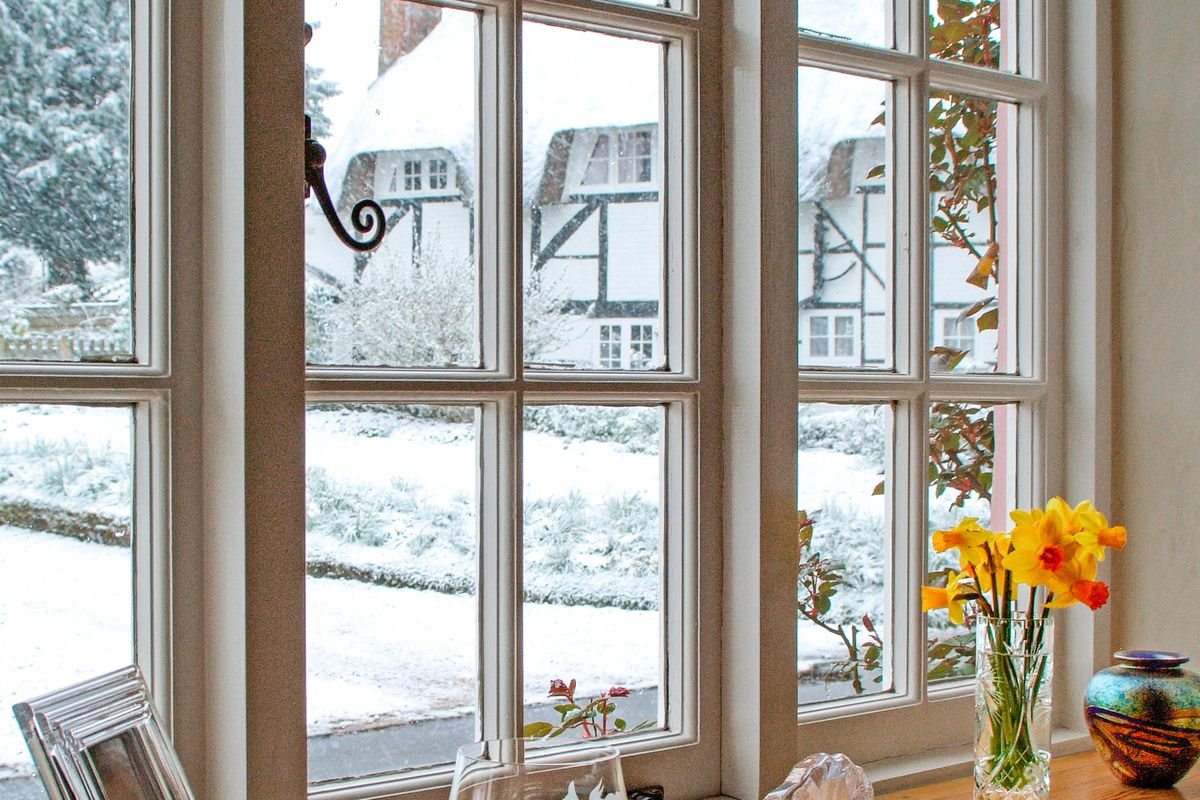When your utility bills creep up, you can blame one of many several factors. Perhaps the cost of heating and cooling has changed. Maybe you’ve just gone through an extremely hot or cold spell.
Or, you may just have some window drafts that are sabotaging your efforts to keep your home comfortable.
Keep reading to learn the signs and causes of drafty windows along with the best ways to combat the pesky draft that has made its way into your home.
Signs You Have Drafty Windows
In addition to higher-than-normal utility bills, you can identify drafty windows with a few telltale signs. Take a tour of your home and examine your windows carefully. Look for these signs.
Cracked or Damaged Seals
Examine the seals around the edges of your windows. Make sure they’re intact.
Older windows sit in wooden casings that expand and contract with time and weather. This movement puts stress on the sealing and causes it to crack over time.
Crooked Windows
If your window is sitting out of its plumb, it cannot create the airtight seal that keeps drafts out. You’ll know you have a problem when you cannot easily close or open these windows. maybe the window has warped overtime or the contractor never installed them properly.
If you have difficulty latching or closing your window, you most likely have found your drafty window and the culprit for higher heating and cooling bills.
Cracked Window Panes
A cracked window pane is the easiest thing to identify. Your window isn’t working to its full capacity if you have a crack in the glass. insulated windows increase energy efficiency by having argon gas in between the panes. Thus, if you have a cracked pane, your window just lost its efficiency.
Moisture Between Window Panes
Moisture on your windows does not necessarily mean you have a drafty window, but it could. Excessive humidity or temperature changes in the house from cooking or showering can cause condensation as well.
However, if you have condensation between your window panes, then the expanding and contracting of the wood that holds your windows in has put a strain on your seals. Over time, these seals wear out and crack, letting moisture into the window panes.
Your Curtains Move
Moving curtains can come from a vent nearby, blowing them and moving them. However, if you have no such vent nearby, then the draft can be coming from your windows. Moving curtains are a visible sign of failing windows.
Causes of Window Issues
Signs of a draft indicate its existence. But what causes the draft in the first place? Understanding the cause of window issues will help you find the best solution for your particular problem.

Window Seals Failed
Primarily, you will see a draft because your window seals have failed. The argon glass between the window panes of double and triple-paned windows will escape when your seals fail. These windows have then become decoration and not energy-efficient.
Seals break for the following reasons:
- The contractor did a poor job of installing the windows.
- The seals broke during window shipment.
- Time has worn down the seals.
- The elements of your environment took a toll on the windows.
- Mold has built up in the seals and caused them to crack.
Failed seals allow outside air to creep through the windows and affect your home’s temperature. Your HVAC will have to work harder to keep your home cool or warm.
Contractor Failure
If a contractor does not install a window to fit properly, you will have a draft. You may notice a gap between the window frame and the window. A licensed contractor will fit windows properly, so plan on hiring a professional for this job to avoid a bigger problem down the road.
Cracked Caulk
Window caulk lines the spots where the window frame meets the building. It keeps drafts out. So if you have cracks in your caulk, you will have drafty windows.
Sometimes the compromised caulk is obvious. To check for cracked caulk, move your hand along the window caulk and feel for a breeze. Check your caulk annually.
Old Windows
If you live in an older home, you most likely have old windows. Single-pane windows in particular tend to be drafty windows.
Older windows are typically not energy efficient either. If you live in the Midwest where wind and cold are a factor, look into vinyl windows as they withstand the elements better than aluminum or wood.
Also, make sure you have double or triple-pane glass in your windows. The argon gas between the panes makes the windows more energy efficient. This design keeps air from escaping your home.
Solve Window Problems
Now that you understand where your draft is coming from, you can learn how to fix a draft. Here are a few basic things you can do on your own.
Lock and Weatherstrip
Always lock your windows. This pulls your windows in and seals them, removing air leaks and drafts.
If you have large windows, consider installing an additional lock to seal them even better.
Then, before you close your locks, pull down o the sash of your double-hung windows and insert weather stripping on the top edge. Then push the stripping into the wash as hard as you can before you lock the window.
Take time to weatherproof your exterior doors as well. Your draft may be coming from your exterior doors and not your windows, so apply weather strips to the top and sides of your exterior doors. Install new door sweeps at the bottom to create a good seal.
Deal With Drafty Doors
If your doors have drafts seeping from under them, purchase a door snake or a door stopper. These long tubes filled with sand will block the draft and keep your home more energy-efficient.
Treat Windows With Layers
When you’re picking out new window treatments, use layers of treatments. Think about combining your heavy drapes with sheer curtains as well as blinds. Then, when the temperatures dip, keep all of your windows closed but raise the blinds to let the sun warm your room.
Consider having a non-functioning window in your room so you don’t have to worry about drafts as much. You will need at least one functioning window in each room to make the room up to code, but otherwise, you can have decorative windows that let light in but keep drafts out.

Fill the Gaps
Purchase a foam rope that comes on a roll to fill your window gaps. You should not be able to fit a fingertip into the gaps in your windows. If you can fit your fingertip into the gap, you need to seal the gap.
Foam rope installs easily. You just unwind it and then cut what you need with scissors.
Caulk Temporarily
If your caulk has worn down, you can apply temporary caulk to seal cracks. Temporary caulk comes on a roll or in tubes. Caulk also does a more efficient job than a gap filler.
Caulk the windows in the fall before winter sets in. Then when spring comes, you can just peel off the caulk or gap filler and open your window.
Use Plastic
Local hardware stores and online retail stores carry window insulation kits that work well to keep out the drafts. These kits consist of a plastic film and an adhesive strip for the window frame.
You just need to adhere the adhesive strip to the window frame. Then stretch the plastic over the strip and stick it on. You can trim the plastic with scissors once you’ve attached it.
Use a hairdryer to smooth out the plastic. Just blow warm air over the plastic, and it will shrink to the size you need it. Those who have perfected this method of window insulation can make the plastic virtually invisible to the naked eye.
Replace Your Windows
The previous tips all work well as simple fixes. You can do them yourself and spend little money in the process. However, they are only a bandaid to a bigger problem.
The only way you can truly deal with a draft window for the long run is to replace your windows. You will need a window contractor to do this. Do not attempt to replace your own window, or you may end up dealing with drafty windows again.
Shop around at places both in your community and here online. Replacing your windows will cost you thousands of dollars. So shop around to find the best bang for your buck.
Do not just purchase the cheapest windows you find. At the same time, know that the most expensive windows aren’t always the most efficient either. Look for Energy Star-rated windows to save yourself the most in the long run.
Energy-efficient windows will save you money on your monthly utility bills. They will cost more at the outset but save you money in the long run.
Extinguish Window Drafts
Window drafts raise energy bills and make your home uncomfortable. But you do not have to live with them. These basic tips should help you extinguish window drafts as well as high energy bills.
Did you find this article helpful? Keep visiting our site for helpful tips and tricks to home management.





